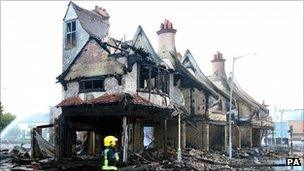London riots: Metropolitan Police response report
- Published
Too few officers were sent on to London's streets during three nights of rioting in August, a Metropolitan Police report has said.
And those who were deployed in Tottenham on the first night did not arrive quickly enough, it added.
The force has released early findings of a review of its actions, with a full report due to be published in December.
It faces a compensation bill of £200m to £300m after more than 3,800 claims were made under the Riot Damages Act.
Scotland Yard said it hoped to recoup the costs through a special grant from the Home Office.
The violence, looting and fires from 6 to 9 August were "very different from anything we had seen in the capital before", the report said.
'Difficult decisions'
There was serious disorder in 22 of the 32 boroughs overseen by the Met, and the geographical spread of the riots was unprecedented, it added.
"Difficult decisions had to be taken at times to prioritise the preservation of life over protection of property," it said.
However, there was "nothing to suggest" senior commanders encouraged those below them to "hold back" from arresting people, and 450 suspects were detained during the disorder, the report said.
And extending courts' opening hours was a "successful" innovation in dealing with those who were charged, it added.
About 3,000 officers were deployed across London on the first night - Saturday - plus 380 public-order officers in Tottenham and the rest of Haringey borough.
By Sunday that had risen to nearly 4,300, while about 6,000 were on the streets on Monday.
"It soon became clear that even the increase to 6,000 officers was not enough and, as such, the number was increased to 16,000 for Tuesday night," the report stated.
"There was very limited disorder that night in London."

Maurice Reeves, whose premises were destroyed, said it was "obvious" there were too few officers
Maurice Reeves, whose family's furniture shop was burned down in Croydon after more than 140 years of trading, said: "I think it was pretty obvious that there were no police down here.
"They were in the Centrale [Shopping Centre] because, I believe, that was where there was inside information that the riots were going to happen."
Rioters "took advantage of that", he added.
After the disorder Brian Paddick, a former Met commander, blamed poor leadership within the force, and said the wrong strategy was adopted.
On Monday he said: "There is no excuse for the police not to have had sufficient resources available on the streets, and the conclusion of this report appears to support that view."
Peter Smythe, chairman of the Metropolitan Police Federation, which represents officers, said the report's findings should be "of no surprise to anybody".
'Riot spread'
"We would say the decision not to have enough police officers clearly meant the Tottenham riot was allowed to happen and spread to other parts of London and, with the benefit of hindsight, was the wrong decision."
The volume and speed of information appearing on social-networking websites during the disorder "posed a significant challenge to policing", the Met report said.
It is to review the way it uses the sites to manage major events in future.
It has also created a unit of investigators, including senior officers, who are being trained in dealing with large-scale public disorder.
- Published25 October 2011